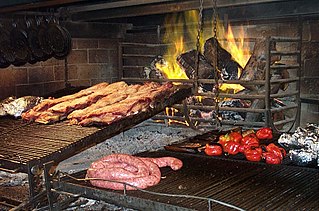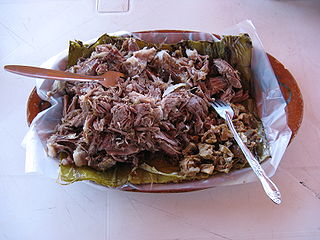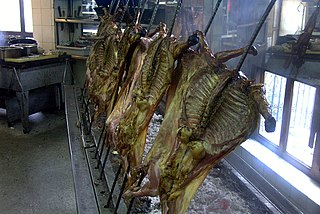This article needs additional citations for verification .(January 2017) |
Chivito (the diminutive of chivo, "goat") is, in Argentina, a type of goat dish.
This article needs additional citations for verification .(January 2017) |
Chivito (the diminutive of chivo, "goat") is, in Argentina, a type of goat dish.
In Argentina, Chivito is the grilled meat of a young goat eaten in Argentina, sometimes as part of an asado . Chivito differs from cabrito in that chivito is a slightly older animal with whose meat is less tender. A chivito has already begun to eat solid foods, whereas the cabrito is still a suckling.
The chivito is less gamey and has a more delicate flavour than the adult goat. It can be cooked a la parrilla (grilled) or a la cruz. In the chivito a la cruz, the chivito is affixed vertically to a cross which is driven into the ground near the fire, giving it a special flavour.
Every summer, a Chivito Festival is held in the town of Malargüe in the province of Mendoza, Argentina.

Argentine cuisine is described as a cultural blending of Mediterranean influences brought by the Spanish during the colonial period and, later, by Italian and Spanish immigrants to Argentina during 19th and 20th centuries, with influences from a further cultural blending of criollos with the Indigenous peoples of Argentina.

Lamb, hogget, and mutton, generically sheep meat, are the meat of domestic sheep, Ovis aries. A sheep in its first year is a lamb and its meat is also lamb. The meat from sheep in their second year is hogget. Older sheep meat is mutton. Generally, "hogget" and "sheep meat" are not used by consumers outside Norway, New Zealand, South Africa and Australia. Hogget has become more common in England, particularly in the North often in association with rare breed and organic farming.

Asado is the technique and the social event of having or attending a barbecue in various South American countries, especially Argentina, Chile and Uruguay where it is also a traditional event. An asado usually consists of beef, pork, chicken, chorizo, and morcilla which are cooked on a grill, called a parrilla, or an open fire. Generally the meats are accompanied by red wine and salads. This meat is prepared by a person who is the assigned asador or parrillero.

Barbacoa is a form of cooking meat that originated in the Caribbean with the Taíno people, who called it by the Arawak word barbaca, from which the term "barbacoa" derives, and ultimately, the word 'barbecue". In contemporary Mexico, it generally refers to meats or whole sheep or whole goats slow-cooked over an open fire or, more traditionally, in a hole dug in the ground covered with agave (maguey) leaves, although the interpretation is loose, and in the present day may refer to meat steamed until tender. This meat is known for its high fat content and strong flavor, often accompanied with onions and cilantro.

Cabrito is the name in both Spanish and Portuguese for roast goat kid in various Iberian and Latin American cuisines.

Cypriot cuisine is a Mediterranean cuisine.

Barbecue varies by the type of meat, sauce, rub, or other flavorings used, the point in barbecuing at which they are added, the role smoke plays, the equipment and fuel used, cooking temperature, and cooking time.

The cuisine of the Democratic Republic of the Congo and the Republic of the Congo varies widely, representing the food of indigenous people. Cassava, fufu, rice, plantain and potatoes are generally the staple foods eaten with other side dishes.

Birria is a Mexican dish from the state of Jalisco. It is a traditional ancestral soup or stew made from a combination of chili pepper-based goat meat adobo, garlic, cumin, bay leaves, and thyme, and cooked at a low heat. Not to be confused with barbacoa, which is cooked underground, birria is slow-stewed in a pot (olla). Beef, lamb sheep or vegan meat substitutes are alternatives for goat. It may be seasoned and garnished with onion, cilantro, and lime. It is commonly accompanied with handmade corn tortillas.

Uruguayan cuisine is a fusion of cuisines from several European countries, especially from Mediterranean foods from Spain, Italy, Portugal and France. Other influences on the cuisine resulted from immigration from countries such as Germany and Scotland. Uruguayan gastronomy is a result of immigration, rather than local Amerindian cuisine, because the new colonies did not trust the native Charrúa people. Spanish influences are very abundant: desserts like churros, flan, ensaimadas yoo (Catalan sweet bread), and alfajores were all brought from Spain. There are also all kinds of stews known as guisos or estofados, arroces, and fabada. All of the guisos and traditional pucheros (stews) are also of Spanish origin. Uruguayan preparations of fish, such as dried salt cod (bacalao), calamari, and octopus, originate from the Basque and Galician regions, and also Portugal. Due to its strong Italian tradition, all of the famous Italian pasta dishes are present in Uruguay including ravioli, lasagne, tortellini, fettuccine, and the traditional gnocchi. Although the pasta can be served with many sauces, there is one special sauce that was created by Uruguayans. Caruso sauce is a pasta sauce made from double cream, meat, onions, ham and mushrooms. It is very popular with sorrentinos and agnolotti. Additionally, there is Germanic influence in Uruguayan cuisine as well, particularly in sweet dishes. The pastries known as bizcochos are Germanic in origin: croissants, known as medialunas, are the most popular of these, and can be found in two varieties: butter- and lard-based. Also German in origin are the Berlinese known as bolas de fraile, and the rolls called piononos. The facturas were re-christened with local names given the difficult German phonology, and usually Uruguayanized by the addition of a dulce de leche filling. Even dishes like chucrut (sauerkraut) have also made it into mainstream Uruguayan dishes.

Lampazos de Naranjo is a city and municipality located in Nuevo León, Mexico. Its name is composed of two parts: the first honors the local plant Xanthosoma robustum, called lampazos in Spanish; the second, de Naranjo, means "of General Naranjo". According to the Mexican Statistics Authority 2000 Census, the municipality had 5,305 inhabitants.

Chilean cuisine stems mainly from the combination of traditional Spanish cuisine, Chilean Mapuche culture and local ingredients, with later important influences from other European cuisines, particularly from Germany, Italy, the United Kingdom and France. The food tradition and recipes in Chile are notable for the variety of flavours and ingredients, with the country's diverse geography and climate hosting a wide range of agricultural produce, fruits and vegetables. The long coastline and the peoples' relationship with the Pacific Ocean add an immense array of seafood products to Chilean cuisine, with the country's waters home to unique species of fish, molluscs, crustaceans and algae, thanks to the oxygen-rich water carried in by the Humboldt Current. Chile is also one of the world's largest producers of wine and many Chilean recipes are enhanced and accompanied by local wines. The confection dulce de leche was invented in Chile and is one of the country's most notable contributions to world cuisine.

Goat meat or goat's meat is the meat of the domestic goat (Capra aegagrus hircus). The common name for goat meat is simply "goat", though meat from adult goats is referred to as chevon, while that from young goats can be called capretto (It.), cabrito or kid. In South Asian and Caribbean cuisine, mutton commonly means goat meat. In South Asia, where mutton curry is popular, "mutton" is used for both goat and lamb meat.

Sundanese cuisine is the cuisine of the Sundanese people of Western Java, and Banten, Indonesia. It is one of the most popular foods in Indonesia. Sundanese food is characterised by its freshness; the famous lalab eaten with sambal and also karedok demonstrate the Sundanese fondness for fresh raw vegetables. Unlike the rich and spicy taste, infused with coconut milk and curry of Minangkabau cuisine, the Sundanese cuisine displays the simple and clear taste; ranged from savoury salty, fresh sourness, mild sweetness, to hot and spicy.

A steak, also sometimes called "beef steak", is a meat generally sliced across the muscle fibers, potentially including a bone. It is normally grilled, though it can also be pan-fried. Steak can also be cooked in sauce, such as in steak and kidney pie, or minced and formed into patties, such as hamburgers.

Goat farming involves the raising and breeding of domestic goats as a branch of animal husbandry. People farm goats principally for their meat, milk, fibre and skins.

The cuisine of Cape Verde is a West African cuisine largely influenced by Portuguese, Southern and Western European and West African cuisine. Cape Verde was a colony of Portugal from its colonization until 1975.